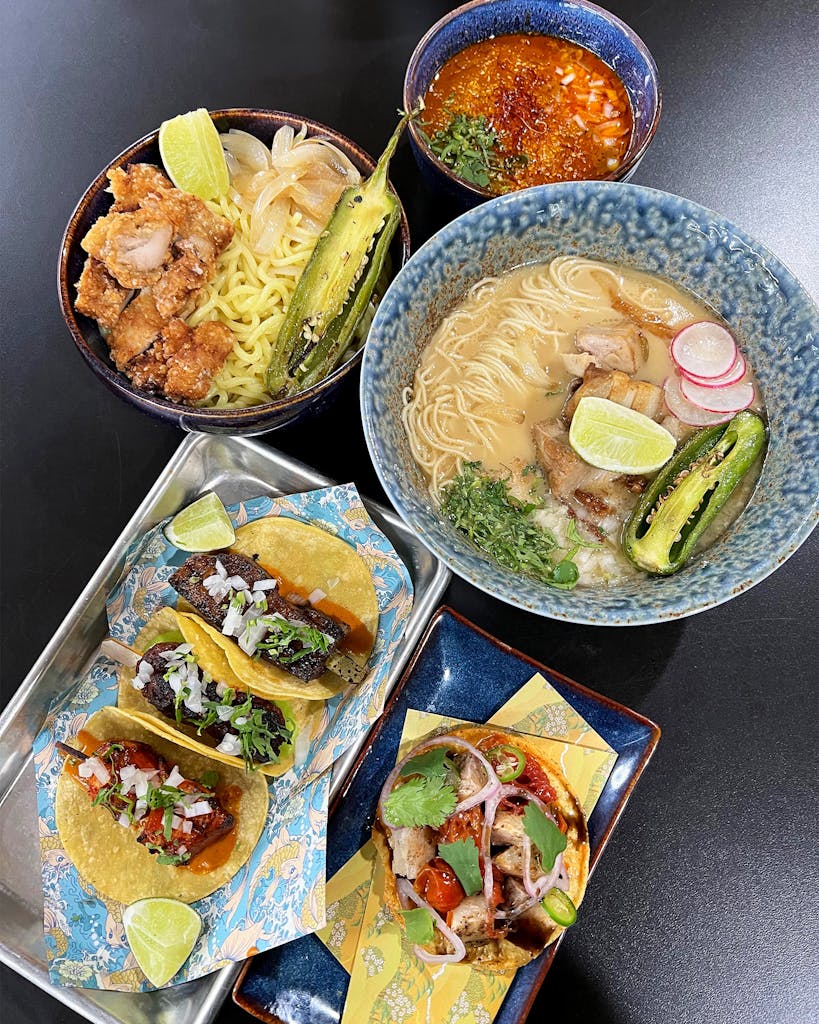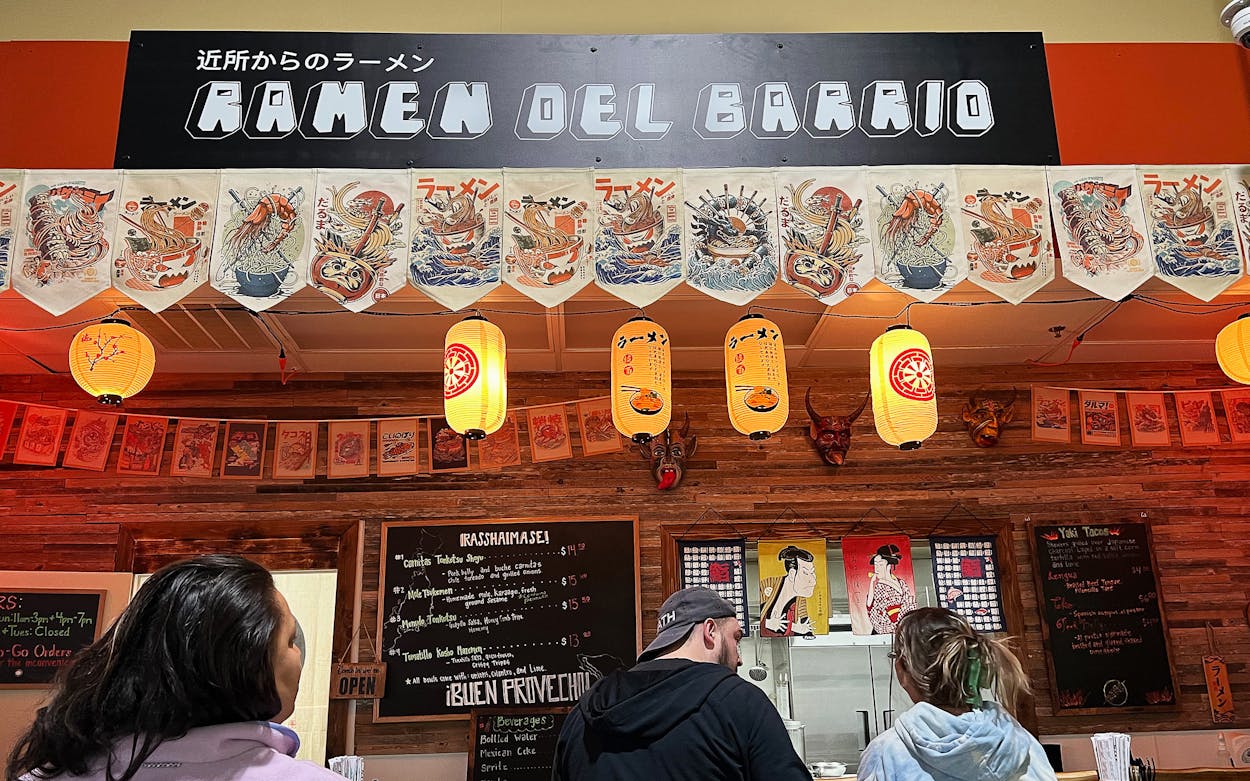Christopher Krinsky would have you believe he is no ramen nerd. He says as much before plowing into a meticulous explanation of the traditional Japanese noodle dish. “Tare is where all of the seasonings come in, and then you have your aromatic oil,” he says as part of his spiel. “The aromatic oil will carry any aromas that you want to get while slurping your ramen right as you’re inhaling.”
Perhaps the chef-owner of Ramen Del Barrio, a two-month-old stall in Austin Asian grocer Hana World Market, is trying to manage expectations and mitigate criticism. He is, after all, an American-born male blending Japanese and Mexican culinary traditions, and he’s weary of accusations of cultural appropriation.
The chefs he’s worked for have prepared him for questioning. “They always told me, if you go out and do Japanese food, the very first question that you’re going to get every time is, ‘Is your mom or is your dad Japanese, or have you ever lived in Japan?’ So I was ready for it,” he says.
Krinsky’s family moved to Isla Mujeres when he was a toddler to open a restaurant on the island off the coast of Mexico’s Yucatán Peninsula, as well as in Cancún. They shuttled between Maine (where Krinsky was born) and Mexico, always operating restaurants. “I was practically born on a kitchen counter,” he jokes. Krinsky attended school in Mexico, and it’s the country he identifies as home. He eventually moved to Austin after high school.
The 24-year-old would rather talk about food than his background. He’s done the reading and put in the practical effort. “I just try to study hard and get good at things,” Krinsky explains. The effort has made Ramen Del Barrio into an exquisite example of the hybridization of Japanese and Mexican food with the bona fides to match.
Ramen Del Barrio began in December 2021 as a series of twice-weekly tastings in Krinksy’s garage. At that point, the business was called Ramen Garage. He liked the intimacy of the setting and the dish’s versatility. “What I love so much about ramen is that it’s very flexible and pliable,” he says. “I’m constantly trying to find ways of doing things my way.” One of those particular renditions was a menudo ramen. “I had just finished eating a bowl of menudo,” he explains. “That kind of created every other bowl that is now part of the Ramen Del Barrio concept.” A year and a half after immersing himself in ramen, Krinsky’s confidence and talent are on clear display at Ramen Del Barrio.

The standouts on the small menu are the carnitas tonkotsu shoyu and the mole tsukemen. The latter features a bowl of noodles as limber and pliant as Olympic divers ready to submerge themselves in a murky orange broth. Atop the noodles are juicy chicken karaage and a bisected chile, its seeds warning of the forthcoming heat. On my first visit, the broth, made from a fresh mole base, had beads of sweat forming on my temples and my lips sizzling. I might have hiccuped once or twice. But the liquid—mouth-coating and pungent—had the spice, sweetness, and final umami rush that Mexican and Japanese food should have.
The broth was more evenly layered on my second visit, with less heat. Regardless, the act of dunking and swirling long tangles of noodles into a vermilion pool is fun. The carnitas tonkotsu shoyu will be a bit more familiar to ramen lovers. The dish’s broth resembled the traditional pork broth base of tonkotsu ramen. The salty sweetness of the carnitas—Krinsky uses pork belly and buche (pork stomach)—shone on both of my visits. I enjoyed slurping and twisting and shoveling the noodles, meat, chiles toreados, and grilled onions into my mouth.
Tacos are the other versatile items on the menu. The tacos at Ramen Del Barrio feature Japanese robata skewers cooked on a Japanese charcoal grill. Each taco is served in a corn tortilla with the filling still on the skewer. My favorite was the lengua. The charred exterior transformed the usually subtle grassy flavor of the beef tongue. With a different taco, curls of octopus rubbed with an al pastor marinade of chile and achiote spun across the palate. On a follow-up visit, I was treated to a beef chorizo taco that left me craving more. There is no higher compliment given to a taco than wanting another despite how full you are. Of the tacos, Krinsky says, “Other than the ramen itself, [they are] the backbone to the fusion structure that we have here.”
The blending of Mexican and Japanese foodways began in 1565 with the Manila galleon shipping lanes between Acapulco and Manila. Traders from across Asia traveled to the Philippines port to barter with their Mexican counterparts, who had ports of call across the Pacific islands, including the Northern Marianas, where a coconut-flavored flour tortilla was developed in the wake of trade. The 250-year exchange introduced myriad ingredients and influences to Mexican culture and cuisine. In the nineteenth and twentieth centuries, Asian immigration—and Japanese immigration specifically—to Mexico increased, leading to innovations like the Baja-style fish taco, whose batter is believed to have been influenced by tempura. James Beard Award semifinalist El Charlatan, from El Paso–Ciudad Juárez chef Enrique Lozano, is another Mexican taqueria and ramen shop pushing the fusion further.
Innovation and fascination aren’t confined to the Americas. Taquerias are also popping up across Japan, including Tacos 3Hermanos and Los Tacos Azules. It’s enough for me to pine for a trip overseas. Tacos don’t recognize borders, and they don’t accept limits. They are a gift to the world, and are treated as such at Ramen Del Barrio. The same, Krinsky says, is true of ramen, but he wants to be careful, saying, “I’m trying to do this as respectfully and thoughtfully as possible.” Ultimately, Krinsky explains Ramen Del Barrio as a love letter to his Mexican upbringing. “We’re using Japanese techniques in our kitchen to produce high-quality ramen, but all of the flavors to me ideally come out tasting pretty Mexican,” he says.
Ramen Del Barrio
Inside Hana World Market
1700 W. Parmer Lane, Suite 100, Austin
Phone: No phone
Hours: Wednesday–Sunday 11–3 and 4–7








